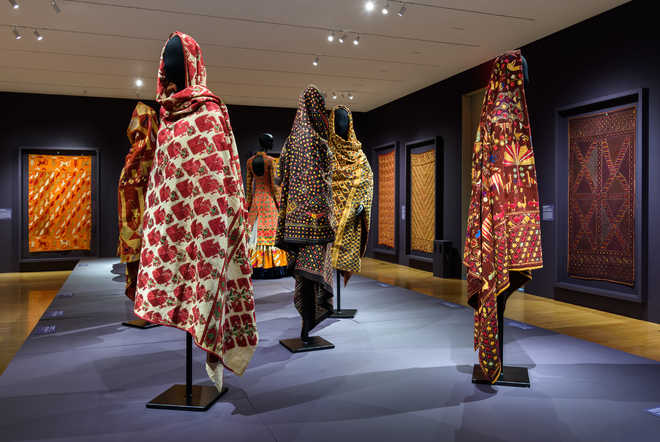Phulkari in Philadelphia
Sarika Sharma
When long-time art collectors from Philadelphia, Jill and Sheldon Bonovitz, first saw Bengali kanthas and Punjabi phulkaris some decades ago, they responded to the imagination, whimsy, and fine craftsmanship of these women’s embroideries and began to form collections of both the crafts. In 2009-10, they supported an exhibition of kanthas and now, seven years later, they have come up with an exhibition of phulkaris at the Philadelphia Museum of Art, with the collection being hailed as the first ever for the Punjabi craft of embroidery in the US.
The Philadelphia museum of art, founded in 1876, is among the oldest and the largest art museums in the United States. It holds world-class collections of both the arts of South Asia and of costumes and textiles from around the world. While the museum has housed a few phulkaris for some time now, a full-fledged exhibition has been put up for the first time.
Darielle Mason, the Stella Kramrisch Curator of Indian and Himalayan Art at the museum, credits the foresight of the two collectors (she a ceramic artist, he a trustee of the museum) in collecting exquisite examples of phulkaris.
Mason co-curated the exhibition with Dilys E. Blum, senior curator of costume and textiles at the museum, and Cristin McKnight Sethi, an assistant professor at the George Washington University. Sethi joined the museum staff first to catalogue the collection and then to become a co-curator of the exhibition and author a major essay on the craft.
Along with the 19 Bonovitz phulkaris, the exhibition includes some historical pieces from the museum’s permanent collection. It also includes information on technique, use and history both as written wall text and through a digital presentation that focuses on Partition and the meaning of phulkaris since 1947. The final element of the exhibition brings these textiles into the present through the contributions of designer Manish Malhotra. On display are baghs, darshan dwars, sainchis, thirmas and chopes, besides the designer’s contemporary designs.
“In the process of our research, the curatorial staff discovered a video of Malhotra’s 2013 collection in which he used phulkari embroidery to create glamorous couture garments. When I was next in Mumbai, I met him to explain our project. We hoped not only to use his video in the installation, but also to borrow some of the original 2013 garments.”
Malhotra agreed to participate in the project and created seven new ‘2017’ phulkari-inspired garments. Three of these are part of the exhibition itself and he has donated these to the museum’s permanent collection of haute couture. Four others were worn by live models at the exhibition opening, to the great enthusiasm of hundreds of art patrons.
However, with scholars having little evidence of extant phulkaris dating from before the 1800s, the earliest works in the exhibition appear to date to the early 1800s and the latest are Malhotra’s creations.
“This special link between the past and the present makes the exhibition truly unique,” Mason says.
Less known in the US, the vivid colours, lively imagery and superlative needlework are flooring people. Mason says the audiences have been enchanted and amazed. And when they come to know that the craft was lost during the Partition of India, they are shocked.
“Visitors have also been fascinated to learn about the region, yet are often shocked that US schools teach virtually nothing about [the Indian] independence and even less about the horrors of Partition on both sides of the border. The exhibition is proving to be an aesthetic as well as historical eye opener for most of our national and international audiences.” The exhibition is on till July 9.
More of South Asia
The Philadelphia Museum of Art opened its newly renovated galleries of South Asian Art in October last. They had been completely transformed for the first time in 40 years. Textiles from South Asia, including Kashmiri shawls, royal Karappur garments, saris and the finest collection of Bengali kantha outside of India/ Bangladesh are among the many glories of the museum









